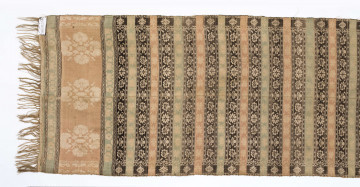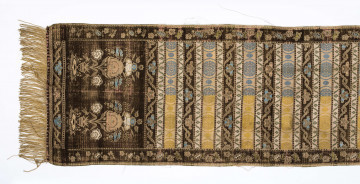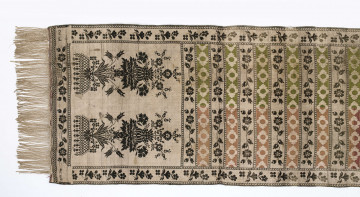
Kontusz belt
1789 — 1800
National Museum in Lublin
Part of the collection: Textiles, embroideries, clothing and costume accessories
A traditional element of the Polish kontusz costume were shoes with a high upper. In the 17th and 18th centuries they were made of goatskin, sapphire leather, extremely delicate and durable; the nobility wore them with great fancy. The refined, ceremonial attire of the wealthy nobleman looked dignified, enriched with red or yellow shoes decorated with gold embroidery. Everyday clothes were worn with shoes made of poorer quality black leather. The preserved shoes in the collection are of an untypical colour, green, but similarly to the few preserved examples of such relics in the Polish collections they are embroidered with gold thread all over with floral motifs. The pattern consists of large peony and tulip flowers as well as smaller bells and forget-me-nots, in keeping with the taste prevailing around the mid-18th century. The flat leather sole was fashionable later, between 1788 and 1792. These features indicate that the shoes were made in the late 18th century. This kind of accessory testified to the social status, wealth of its owner. The need to emphasise social position, also by the detail of the outfit, is illustrated by the adage "You can tell a gentleman by his uppers". Therefore, the poor nobility and burghers would purchase old safari shoes and fill in the gaps with black leather, so that the worn colour of the shoes, red or yellow, testified to the good origins of their owner and the long-term ownership of a costly luxury item. An additional financial difficulty when ordering a new pair was the fact that larger sizes were more expensive, the price depending not on the work involved, but on the amount of leather used. The most valuable and sought-after was Morocco leather from Turkey. The name of the shoes, bachmags, which comes from the Turkish language, became popular. In 1615 Marcin Paszkowski wrote: "In Turkey common footwear wives with husbands have, which there their language calls bachmags". This term survived in the Polish language until the mid-19th century, at which time it began to appear in dictionaries as obsolete. Half a century earlier, the kontusz outfit was also considered anachronistic and almost completely fell out of use.
Magdalena Norkowska
Author / creator
Dimensions
cały obiekt: height: 19,5 cm, width: 32 cm
Object type
an item of clothing
Technique
embroidery
Material
flax canvas, gold metal thread
Creation time / dating
Creation / finding place
Owner
The National Museum in Lublin
Identification number
Location / status

1789 — 1800
National Museum in Lublin

1770 — 1800
National Museum in Lublin

1780 — 1800
National Museum in Lublin
DISCOVER this TOPIC
Castle Museum in Łańcut
DISCOVER this PATH
Educational path